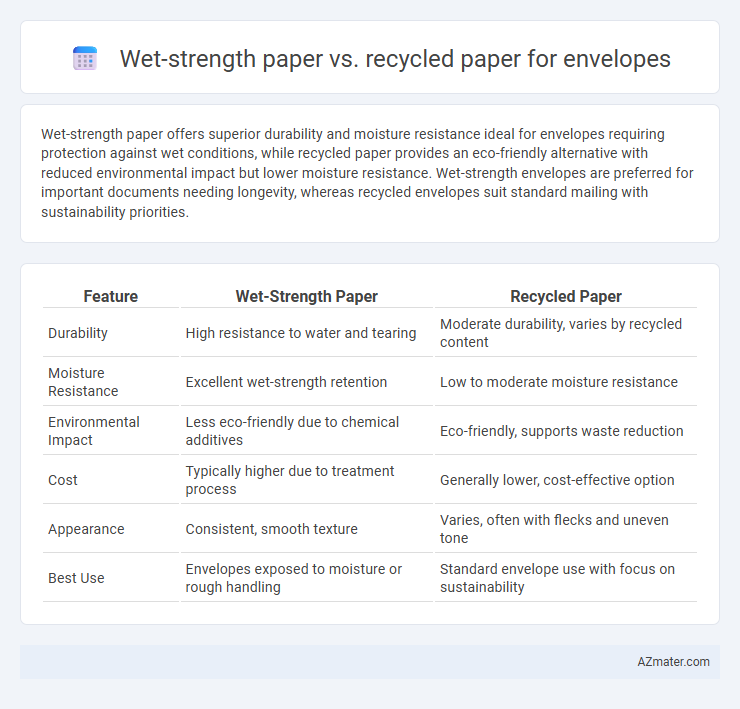Wet-strength paper offers superior durability and moisture resistance ideal for envelopes requiring protection against wet conditions, while recycled paper provides an eco-friendly alternative with reduced environmental impact but lower moisture resistance. Wet-strength envelopes are preferred for important documents needing longevity, whereas recycled envelopes suit standard mailing with sustainability priorities.
Table of Comparison
| Feature | Wet-Strength Paper | Recycled Paper |
|---|---|---|
| Durability | High resistance to water and tearing | Moderate durability, varies by recycled content |
| Moisture Resistance | Excellent wet-strength retention | Low to moderate moisture resistance |
| Environmental Impact | Less eco-friendly due to chemical additives | Eco-friendly, supports waste reduction |
| Cost | Typically higher due to treatment process | Generally lower, cost-effective option |
| Appearance | Consistent, smooth texture | Varies, often with flecks and uneven tone |
| Best Use | Envelopes exposed to moisture or rough handling | Standard envelope use with focus on sustainability |
Introduction to Envelope Paper Types
Envelope paper types include wet-strength paper, which is engineered with additives to resist disintegration when exposed to moisture, ensuring durability during handling and mailing. Recycled paper, made from reclaimed fibers, offers an eco-friendly alternative that reduces environmental impact while maintaining adequate strength and printability for standard correspondence. Selecting between wet-strength and recycled paper depends on the envelope's intended use, balancing moisture resistance and sustainability.
What is Wet-Strength Paper?
Wet-strength paper is a type of paper treated with special resins or chemicals to maintain its structural integrity when exposed to moisture, making it ideal for envelopes subject to damp conditions. This enhanced durability contrasts with recycled paper envelopes, which may lack moisture resistance despite eco-friendly benefits. The wet-strength treatment ensures envelopes remain strong and intact during mailing or storage, especially in humid environments.
Understanding Recycled Paper
Recycled paper for envelopes is made from post-consumer waste, reducing environmental impact and conserving natural resources. Unlike wet-strength paper, which contains additives to resist moisture and strengthen durability, recycled paper prioritizes sustainability but may lack the same water resistance. Understanding recycled paper's fiber quality and processing helps ensure envelopes meet functional needs while supporting eco-friendly practices.
Strength and Durability Comparison
Wet-strength paper for envelopes offers enhanced durability due to its chemical additives that resist moisture, ensuring the envelope maintains integrity even in damp conditions. Recycled paper envelopes, while environmentally friendly, generally have lower wet strength and may weaken or tear when exposed to humidity or water. For applications requiring robust protection and longevity, wet-strength paper provides superior performance compared to recycled paper options.
Water Resistance Capabilities
Wet-strength paper offers superior water resistance for envelopes, maintaining integrity and preventing tearing when exposed to moisture, making it ideal for important documents requiring durability. Recycled paper generally has lower water resistance due to fiber degradation during the recycling process, which reduces its ability to withstand wet conditions. Choosing wet-strength paper enhances envelope performance in wet environments, ensuring contents remain protected against water damage.
Environmental Impact Assessment
Wet-strength paper for envelopes contains chemical additives that enhance durability and water resistance but complicate recycling due to the persistence of resins, leading to increased environmental burdens during processing and disposal. Recycled paper envelopes significantly reduce landfill waste and lower energy consumption in production, contributing to a smaller carbon footprint and fewer pollutants released. Life cycle assessments consistently show recycled envelopes offer superior environmental benefits by conserving natural resources and minimizing ecological impact compared to wet-strength alternatives.
Cost Analysis: Wet-Strength vs Recycled Paper
Wet-strength paper for envelopes generally incurs higher production costs due to specialized resin treatments enhancing durability and moisture resistance, making it pricier than recycled paper. Recycled paper offers cost advantages by utilizing post-consumer waste, reducing raw material expenses and environmental impact. However, wet-strength paper's superior performance in moisture environments can justify its premium price for applications demanding enhanced envelope resilience.
Printability and Customization Options
Wet-strength paper offers superior printability with its smooth surface and excellent ink adhesion, making it ideal for high-quality, vibrant envelope designs. Recycled paper tends to have a rougher texture, which can affect print clarity but provides unique, rustic customization options that appeal to eco-conscious brands. Both materials support a range of printing techniques, but wet-strength paper ensures more precise detail retention for intricate custom artwork and text.
Suitability for Mailing and Logistics
Wet-strength paper offers superior durability and resistance to moisture, making it highly suitable for mailing envelopes exposed to varying weather conditions or rough handling in logistics. Recycled paper, while environmentally friendly, generally lacks the robustness required for long-distance mailing, potentially compromising the integrity of the envelope during transit. For reliable protection and secure delivery, wet-strength paper envelopes are preferred in demanding postal and shipping environments.
Choosing the Best Paper for Envelopes
Choosing the best paper for envelopes involves evaluating wet-strength paper and recycled paper based on durability and environmental impact. Wet-strength paper offers superior resistance to tearing and moisture, ideal for protecting contents during transit. Recycled paper supports sustainability goals, reducing environmental footprint while providing adequate strength for everyday mailing needs.

Infographic: Wet-strength paper vs Recycled paper for Envelope
 azmater.com
azmater.com